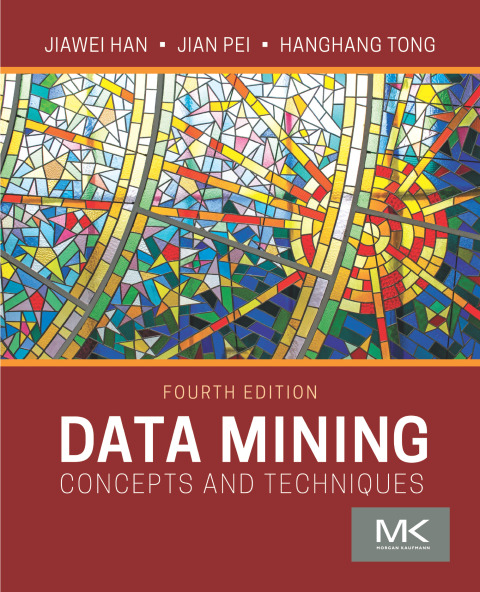Description
Efnisyfirlit
- Cover image
- Title page
- Table of Contents
- Copyright
- Dedication
- Foreword
- Foreword to second edition
- Preface
- Organization of the book
- To the instructor
- To the student
- To the professional
- Book web site with resources
- Acknowledgments
- About the authors
- Chapter 1: Introduction
- 1.1. What is data mining?
- 1.2. Data mining: an essential step in knowledge discovery
- 1.3. Diversity of data types for data mining
- 1.4. Mining various kinds of knowledge
- 1.5. Data mining: confluence of multiple disciplines
- 1.6. Data mining and applications
- 1.7. Data mining and society
- 1.8. Summary
- 1.9. Exercises
- 1.10. Bibliographic notes
- Bibliography
- Chapter 2: Data, measurements, and data preprocessing
- 2.1. Data types
- 2.2. Statistics of data
- 2.3. Similarity and distance measures
- 2.4. Data quality, data cleaning, and data integration
- 2.5. Data transformation
- 2.6. Dimensionality reduction
- 2.7. Summary
- 2.8. Exercises
- 2.9. Bibliographic notes
- Bibliography
- Chapter 3: Data warehousing and online analytical processing
- 3.1. Data warehouse
- 3.2. Data warehouse modeling: schema and measures
- 3.3. OLAP operations
- 3.4. Data cube computation
- 3.5. Data cube computation methods
- 3.6. Summary
- 3.7. Exercises
- 3.8. Bibliographic notes
- Bibliography
- Chapter 4: Pattern mining: basic concepts and methods
- 4.1. Basic concepts
- 4.2. Frequent itemset mining methods
- 4.3. Which patterns are interesting?—Pattern evaluation methods
- 4.4. Summary
- 4.5. Exercises
- 4.6. Bibliographic notes
- Bibliography
- Chapter 5: Pattern mining: advanced methods
- 5.1. Mining various kinds of patterns
- 5.2. Mining compressed or approximate patterns
- 5.3. Constraint-based pattern mining
- 5.4. Mining sequential patterns
- 5.5. Mining subgraph patterns
- 5.6. Pattern mining: application examples
- 5.7. Summary
- 5.8. Exercises
- 5.9. Bibliographic notes
- Bibliography
- Chapter 6: Classification: basic concepts and methods
- 6.1. Basic concepts
- 6.2. Decision tree induction
- 6.3. Bayes classification methods
- 6.4. Lazy learners (or learning from your neighbors)
- 6.5. Linear classifiers
- 6.6. Model evaluation and selection
- 6.7. Techniques to improve classification accuracy
- 6.8. Summary
- 6.9. Exercises
- 6.10. Bibliographic notes
- Bibliography
- Chapter 7: Classification: advanced methods
- 7.1. Feature selection and engineering
- 7.2. Bayesian belief networks
- 7.3. Support vector machines
- 7.4. Rule-based and pattern-based classification
- 7.5. Classification with weak supervision
- 7.6. Classification with rich data type
- 7.7. Potpourri: other related techniques
- 7.8. Summary
- 7.9. Exercises
- 7.10. Bibliographic notes
- Bibliography
- Chapter 8: Cluster analysis: basic concepts and methods
- 8.1. Cluster analysis
- 8.2. Partitioning methods
- 8.3. Hierarchical methods
- 8.4. Density-based and grid-based methods
- 8.5. Evaluation of clustering
- 8.6. Summary
- 8.7. Exercises
- 8.8. Bibliographic notes
- Bibliography
- Chapter 9: Cluster analysis: advanced methods
- 9.1. Probabilistic model-based clustering
- 9.2. Clustering high-dimensional data
- 9.3. Biclustering
- 9.4. Dimensionality reduction for clustering
- 9.5. Clustering graph and network data
- 9.6. Semisupervised clustering
- 9.7. Summary
- 9.8. Exercises
- 9.9. Bibliographic notes
- Bibliography
- Chapter 10: Deep learning
- 10.1. Basic concepts
- 10.2. Improve training of deep learning models
- 10.3. Convolutional neural networks
- 10.4. Recurrent neural networks
- 10.5. Graph neural networks
- 10.6. Summary
- 10.7. Exercises
- 10.8. Bibliographic notes
- Bibliography
- Chapter 11: Outlier detection
- 11.1. Basic concepts
- 11.2. Statistical approaches
- 11.3. Proximity-based approaches
- 11.4. Reconstruction-based approaches
- 11.5. Clustering- vs. classification-based approaches
- 11.6. Mining contextual and collective outliers
- 11.7. Outlier detection in high-dimensional data
- 11.8. Summary
- 11.9. Exercises
- 11.10. Bibliographic notes
- Bibliography
- Chapter 12: Data mining trends and research frontiers
- 12.1. Mining rich data types
- 12.2. Data mining applications
- 12.3. Data mining methodologies and systems
- 12.4. Data mining, people, and society
- Bibliography
- Appendix A: Mathematical background
- 1.1. Probability and statistics
- 1.2. Numerical optimization
- 1.3. Matrix and linear algebra
- 1.4. Concepts and tools from signal processing
- 1.5. Bibliographic notes
- Bibliography
- Bibliography
- Bibliography
- Index






Reviews
There are no reviews yet.